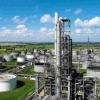|
|
How To Analysis The Appropriate Design Pressure And Temperature In The
#1

Posted 18 May 2010 - 08:10 AM
I need to find out an appropriate design pressure/temperature, and operating preesure/temperature for
the flow element, control valve, etc on this pumping system.
I understand that we choose pump shutoff pressure as D.P. and
suction vessel design temperautre as D.T. for the route between suction vessel and pump.
For the route between pump discharge to tank, we have to choose pump shutoff pressure as D.P.
But,in some case, there may be have a spec break on the pipe before the pump discharge to the tank.
How can we decide the D.P.and D.T. for the pipe line after the spec break to the tank.
Could any master give me a kindly help and explaintion for this and other case such as D.P./D.T. analysis on PSV inelt, outlet, or cooling water header, drain.
Thank you very much.
#2

Posted 21 May 2010 - 02:01 AM
One more point, where you have a duty / standby centrifugal pump configuration and no PSVs on the delivery lines you should make the suction lines rated for the shut-off pressure up to the suction isolation valve. This mitigates the risk of the duty pump pressuring the standby pump suction line via a leaking check valve on the discharge.
Hope this is clear, unfortunately I found your other questions a little too general to answer within this post.
Attached Files
#3

Posted 21 May 2010 - 05:23 AM
Your questions would be much easy to answer if you provided a sketch of the system we are talking about. The discharge of the pump should be rated for the shut-off pressure the pump can deliver, if there are no PSVs. There can be a spec break on the last valve upstream of the destination vessel to a lower pressure rating provided the vessel has sufficient protection against overpressure. The spec break maybe at a SDV that will close to protect the vessel when high discharge pressure is observed on the pump delivery. The vessel PSV would have to be sized for the relief rate caused by closing the vessel outlets whilst the pump is running. The other option is to install PSVs on the pump discharge upstream of isolation valves so that the shut-off pressure can never be observed - this is may be the preferred solution. I have provided a sketch to explain this. Whether you install PSVs or rate the discharge piping to cope with the pump shut-off pressure is dependant on which option is viewed as safer design, more reliable, easy to maintain and service, and which is cheaper. Sometimes eliminating PSVs, if it can done so safely, is beneficial as it removes items that require regular inspection and servicing.
One more point, where you have a duty / standby centrifugal pump configuration and no PSVs on the delivery lines you should make the suction lines rated for the shut-off pressure up to the suction isolation valve. This mitigates the risk of the duty pump pressuring the standby pump suction line via a leaking check valve on the discharge.
Hope this is clear, unfortunately I found your other questions a little too general to answer within this post.
In option 2 of your pump sketch using SDV in minimum flow line and spec break at this point is not clear.
#4

Posted 21 May 2010 - 05:37 AM
It's not essential, but I have known company's to request SDVs on minimum flow recycle lines so that on LAHH or PAHH in the vessel you can ensure that all inlets to the vessel are isolated. It's debatable if its useful as the pumps are likely be tripped for either of this events.
rgds
daryon
#5

Posted 21 May 2010 - 09:02 AM
Hi Fallah,
It's not essential, but I have known company's to request SDVs on minimum flow recycle lines so that on LAHH or PAHH in the vessel you can ensure that all inlets to the vessel are isolated. It's debatable if its useful as the pumps are likely be tripped for either of this events.
rgds
daryon
Hi Daryon,
In the case of PAHH or LAHH the pump is likely being tripped and there is no flow in min flow line!
Anyway,you should follow company standard.
Regarding spec break in min flow line,don't you think at least it can be shifted from SDV to FCV? Or that is among company standard,too?
Regards
#6

Posted 23 May 2010 - 04:25 AM
Hi Daryon,
In the case of PAHH or LAHH the pump is likely being tripped and there is no flow in min flow line!
Anyway,you should follow company standard.
Regarding spec break in min flow line,don't you think at least it can be shifted from SDV to FCV? Or that is among company standard,too?
Regards
[/quote]
I agree Fallah, for the reason you state it really is questionable what value a SDV gives on the minimum flow recycle line. I would not normally include it. If it is installed (perhaps for a scenario where the pumps are not stopped on PAHH or LAHH), then the spec break is better taken downstream of the SDV to avoid any potential for the section downstream of the FCV - and upstream of the SDV - seeing pressure above its DP.
#7

Posted 23 May 2010 - 05:19 AM
If it is installed (perhaps for a scenario where the pumps are not stopped on PAHH or LAHH), then the spec break is better taken downstream of the SDV to avoid any potential for the section downstream of the FCV - and upstream of the SDV - seeing pressure above its DP.[/font]
Actually,i meant when the pump being tripped (as a cause) because of continuing upstream flow,LAHH or PAHH may be occured (as a consequence) not vice versa.Anyway,putting SDV downstream of the FCV (min flow control valve) may increase potential of min flow blockage in the case of SDV close stuck.
Edited by fallah, 23 May 2010 - 05:20 AM.
Similar Topics
Steam Pressure In Heat ExchangerStarted by Guest_mvanrijnbach_* , 15 Apr 2025 |
|

|
||
Scrubber DesignStarted by Guest_nasss_* , 07 Aug 2024 |
|

|
||
Critical Pressure For Choke Valve SizingStarted by Guest_Sherif Morsi_* , 07 Nov 2017 |
|

|
||
Refinery Lpg Deethanizer Column DesignStarted by Guest_Ilyes_* , 15 Feb 2025 |
|

|
||
Alkaline Electrolytic Cell/stack Sizing/design For H2 ProductionStarted by Guest_BRS09_* , 13 Mar 2025 |
|

|

 FB
FB








